Walls of glass: How to decorate a NYC apartment with floor-to-ceiling windows
- You're paying for the view, so the decorating goal is to accentuate it
- Challenges include privacy, blocking light in bedrooms, and UV rays
- Smart solar shades come with blackout options for bedroom
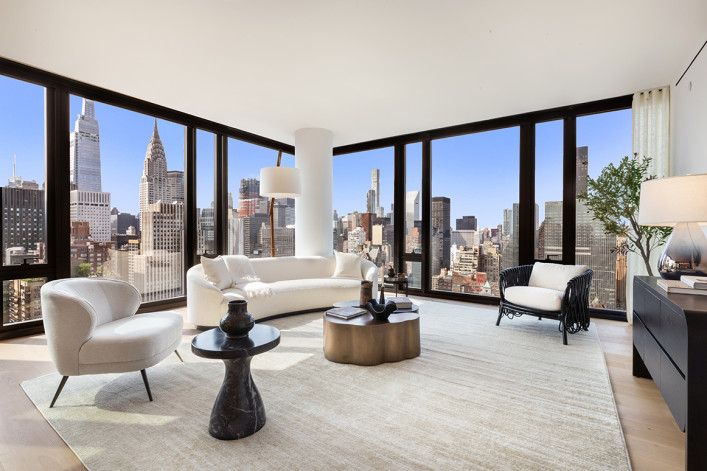
Guillaume Coutheillas of frenchCALIFORNIA staged this model residence at One United Nations Park to emphasize the floor-to-ceiling windows.
Courtesy One United Nations Park
One of the special things about living in New York City is that in many areas, if you live on a higher floor, you can have a pretty spectacular view. It might not be the Chrysler Building perfectly framed by your living room window, but it could very well include water, bridges, or a swath of the Manhattan (or another borough’s) skyline.
Apartments with floor-to-ceiling windows maximize the impact of those views. Initially a wow-worthy selling feature in pricey condo projects by architects like Richard Meier, who is credited with making glass residential buildings popular in NYC, floor-to-ceiling windows are now common at a broader range of prices, which means more New Yorkers are living with them.
Many owners have also blown out the back of their brownstones to create walls of glass in these low-rise residences with views of lush gardens instead of cityscapes.
[Editor's note: A previous version of the article ran in May 2019. We are presenting it again with updated information for November 2023.]
But as desirable as floor-to-ceiling windows are, living with them can present challenges when it comes to privacy, furniture placement, and even interior temperatures.
Brooklyn-based interior designer and architect Jamie Alexander, who has clients in Meier's On Prospect Park in Park Slope, as well as in the more recently constructed glass-walled condos along Brooklyn's Fourth Avenue, says despite the challenges, she’s never encountered buyer’s remorse, even from those who didn’t completely think through all the issues a glass wall or two could present.
“No one’s ever regretted it. There’s no way to create more light if you don’t have it,” she says.
To find out the best ways to showcase your walls of glass and the views they provide, and deal with the issues they can present, Brick Underground surveyed a few interior designers. Here’s what they advise.
Accentuate the view
Of course, if you’ve paid the money for those windows, you’re going to want to make the most of them. That means framing the view well.
For residence 42H in One United Nations Park (shown at top), Guillaume Coutheillas, an interior designer at frenchCALIFORNIA, says he accentuated the views by opting for a neutral color palette and low furniture.
"From the paint and wall finishes to the hues of the furniture, everything was chosen in neutral shades of creams, beiges, grays, and whites," he says, adding that they "took a more minimalistic approach when it came to selecting art and accessories, allowing the eye to draw towards the windows and views naturally."
Showcasing a striking piece of art or other decorative object with the window as a backdrop also keeps the view as the focal point.
Alexander likes to use drapery in a bold pattern or texture. “That can take a gorgeous view to the next level,” she says.
Sometimes no window treatment is the answer, such as when privacy is not an issue.
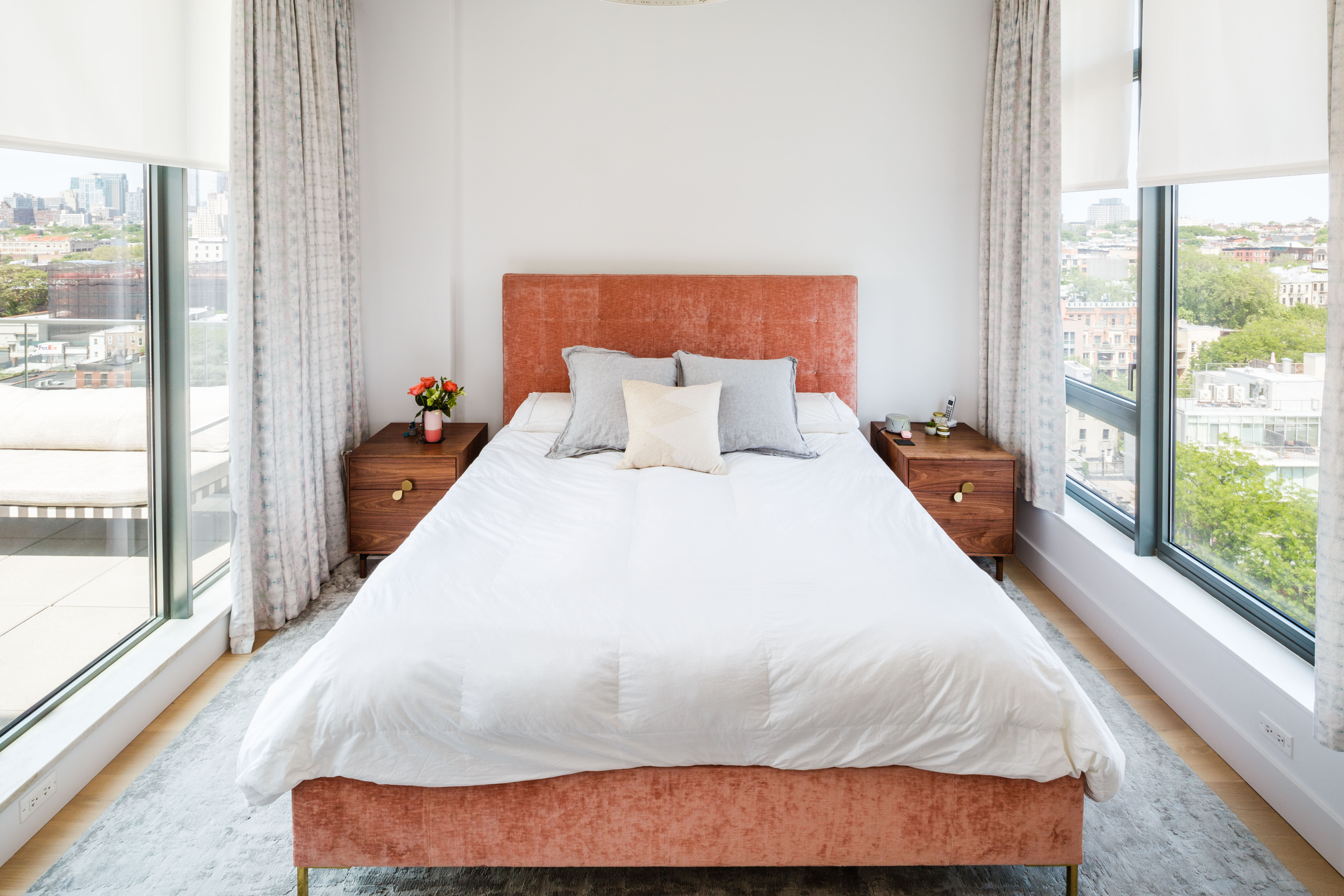
But lose it—and the light—when you need to
Having really big windows means a clear view out, but of course, it also means a clear view in—especially at night.
“Living in an apartment with floor-to-ceiling windows can also feel like living in a fishbowl,” Alexander says. You’ll want to be able to close the drapes easily, and blackout curtains or blinds are essential for any room where someone sleeps.
Blackout shades (usually solar or honeycomb) are widely available in a wide range of fabrics and other options, including manual, cordless, battery-operated, and remote-control in custom sizes from Blinds.com, Blinds to Go, and Blinds Chalet, and Smith & Noble.
The Roller Shade by CityShade comes in a day/night option for dual filtered light and complete privacy; sample pricing for a 118-by-120-inch shade is $1,842 (currently 50 percent off).
Serena Smart Roller Shades by Lutron are a designer favorite and can be integrated into your smart home system. MySmartRollerShades by SmarterHome are also highly rated and start at around $328.
“In bathrooms or other areas where privacy is a concern, we often do a film on the window or have a door built in that serves as a shield,” says Jessica Iwaniec, design director of Pembrooke & Ives, which designed the interiors for the model apartments at The Park Loggia at 15 West 61st.
You may also want to have some privacy in common areas, especially when it's dark outside and there are other glass-walled towers nearby.
Coutheillas says they chose sheer linen and wool curtains for the model residence at One United Nations Park "as they can easily be pulled aside to maximize natural light during the day while still providing some privacy when needed. Lighting was strategically placed to enhance the views during the evening, and we chose adjustable fixtures where possible to create different moods."
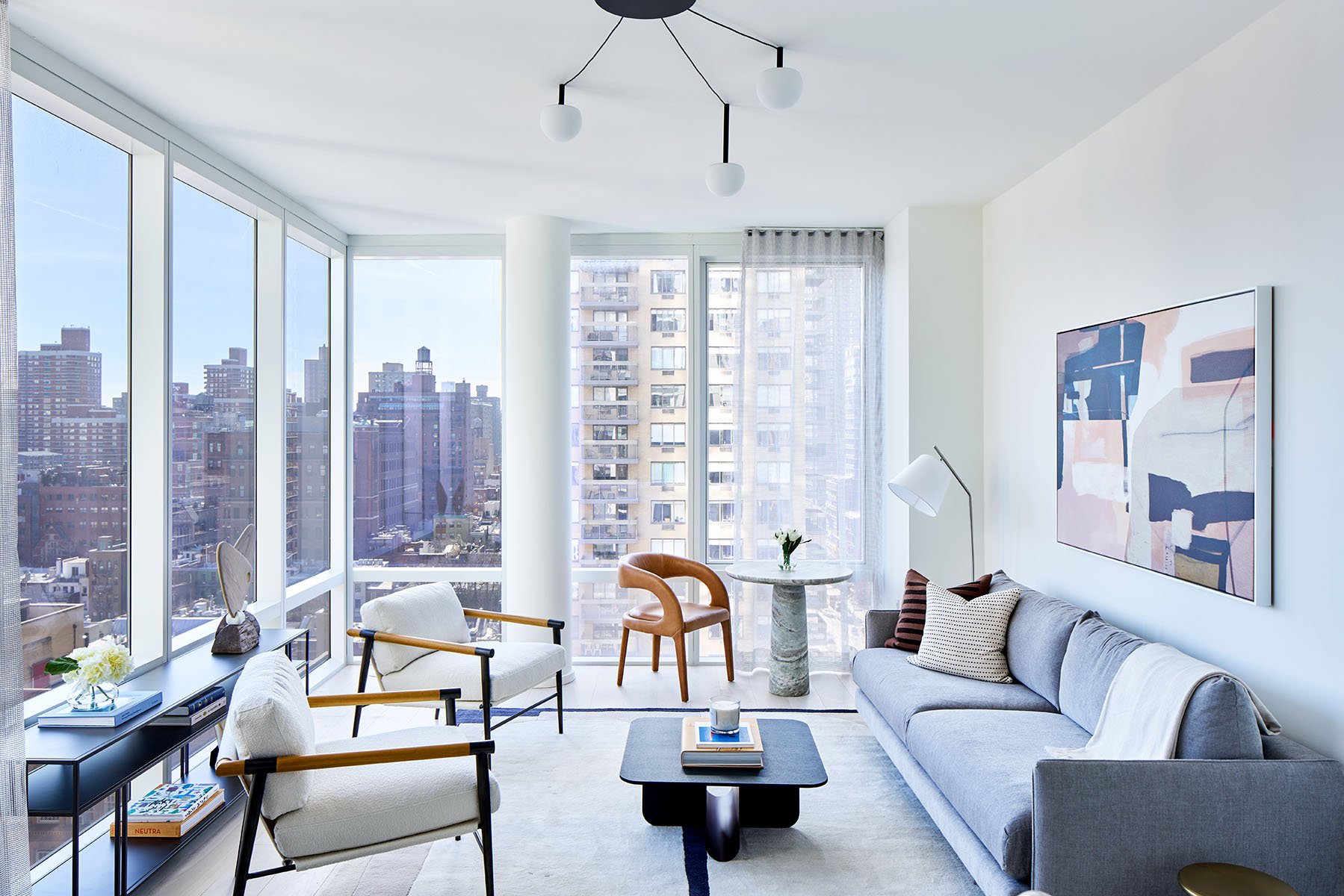
Think about UV rays and glare
All that sunlight does have some downsides, including fading fabric and fine art, as well as casting annoying glare on any kind of screen.
Solar shades, which allow light but block glare and protect from sun damage, will help with this. They come in varying degrees of opacity, so installing them doesn’t mean losing your view. They can also be layered with drapes for as-needed filtering.
Iwaniec likes Lutron solar shades. (The companies mentioned above all offer solar shades as well.)
She also likes using sheer fabric for curtains to allow natural light to come through while maintaining privacy, such as in the dining area below. "Because this is a public space, blocking out the light is not necessary here," she says.
"Sheer curtains, as used in the residence we designed at Eastlight (above), are a great way to control and soften the overall light level in a glass-enclosed space without blocking all the natural light and views, says Ximena Rodriguez, principal and director of interior design at CetraRuddy. "They can also add a level of privacy if desired.”
| How to decorate a NYC apartment with floor-to-ceiling windows | |
|---|---|
| Accentuate the view |
|
| Be strategic with furniture |
|
| Block out light as needed |
|
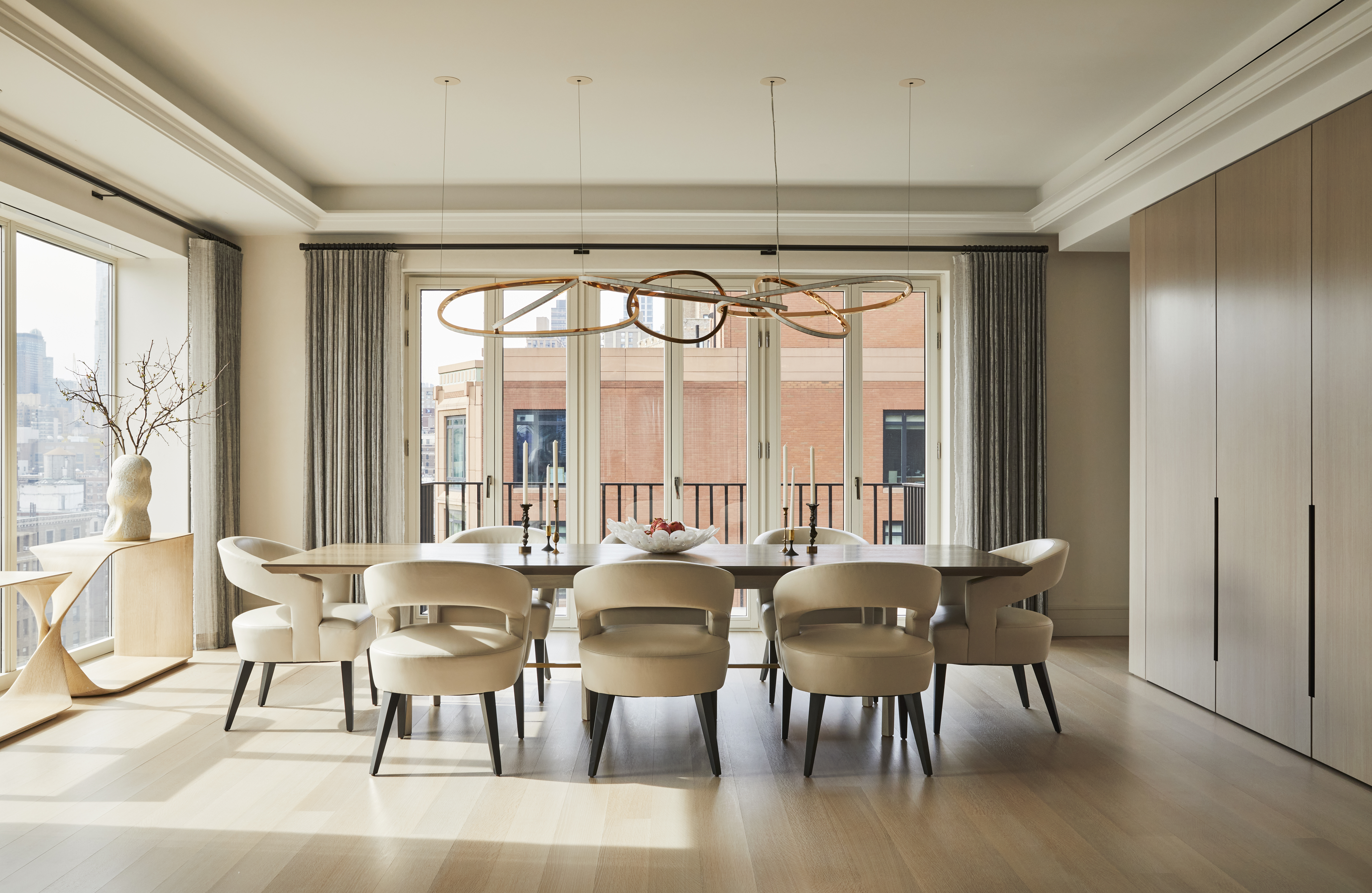
Don’t skimp on window treatment installation
It may be tempting to try to save some money on what will likely be a hefty expenditure, but there are a few reasons why you shouldn’t.
For one, it’s rare that ceilings and floors are perfectly parallel. Professional installers will measure in a way most non-professionals won’t. Correct measurements will ensure the fabric is finished properly on the bottom.
Secondly, the weight of the fabric is not insignificant, and you want someone who knows the proper hardware needed for the job.
"It’s not cheap, and you want to get it right because it’s a very expensive mistake if you don’t,” Alexander says.
Iwaniec points out that since you’re likely dealing with a fair amount of fabric in your drapery, it’s important to allow space for the “stack” created when the curtains are open.
Working with a designer is your best bet, though Lutron, Smith & Noble, and other vendors offer free in-home design and measurement services.
Quality fabric is important, too—you don’t want it to stretch. Iwaniec recommends Hartmann & Forbes for window treatment materials.
Zarin Fabrics is a local institution with over 10,000 rolls of name-brand textiles in its Lower East Side warehouse. Rumor has it you can even show a photo of a coveted pattern and they'll try and hunt it down for you.
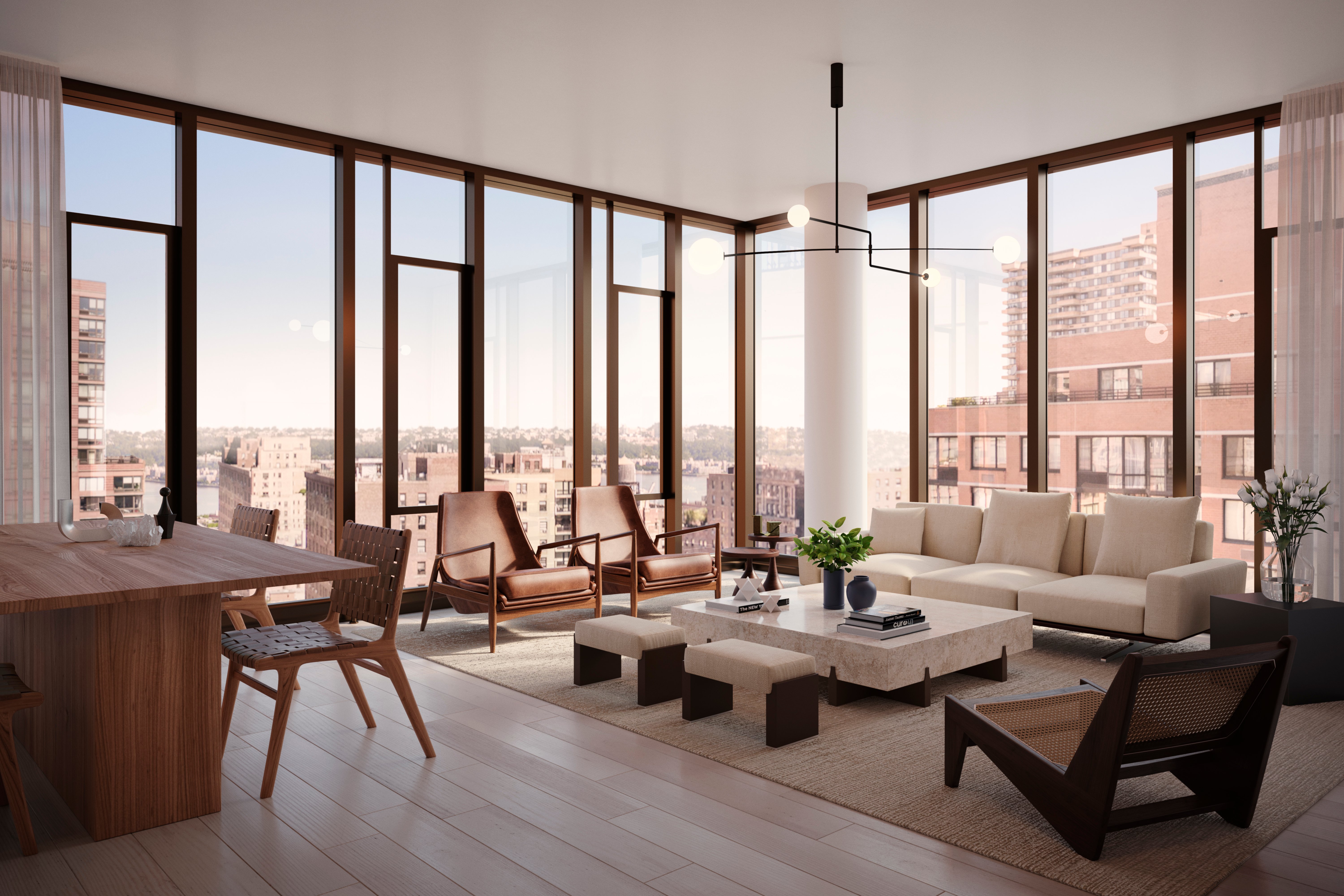
Be strategic about furniture placement
A wall of windows, in some ways, means one less wall to put furniture against, which can be challenging when it comes to the placement of pieces. Putting a desk in front of a window will cause eye fatigue if you’re looking at a computer screen.
A solution Alexander suggests is to float a more sculptural sofa in the living space and place smaller, occasional pieces such as console tables along a window. She’s also had success running a dining table in line with a glass wall, with a mirror positioned on the opposite side, creating a dramatic “glass room” of sorts.
To create a gracious and airy feel, Nancy Ruddy, co-founder of architecture and design firm CetraRuddy, which designed the Upper West Side building Dahlia as well as 200 East 59th St. and Eastlight in Kips Bay (shown above) recommends positioning furniture about two feet from the windows, so sofas and chairs aren’t right up against the glass.
“Arranging furniture so it is well-proportioned and centered in the room helps also, and you should be careful not to block key sight lines,” she says.
At 31 Grove St., a historic 19th-century townhouse in the West Village where a three-story modern wall of windows overlooks a private garden in the rear, the furniture and art are placed strategically around these windows to allow easy access to outdoor entertainment spaces.

Plan for flexibility of use
Alexander points out that sometimes a room needs to accommodate more than one purpose, which may be in conflict. “Day and night may be different scenarios,” she says. For example, a bedroom where you need to sleep or an office where you need to work but where you also want to enjoy the view.
Here, she often enlists custom-made furniture that can serve multiple functions, as well as furniture that swivels or is easy to move. “Flexibility becomes part of the lifestyle,” she says.
Budget for heating and cooling
While not really an interior design consideration, apartments with floor-to-ceiling windows get hot in the summer and cold in the winter. Glass just doesn’t insulate as well as brick or plaster. Expect your energy bill to go up. One of Alexander’s clients told her, “I never thought I’d spend so much heating and cooling my apartment.”
However, window treatments will function as both an aesthetic element and help with climate control.
“Well-thought-out window treatments can add a sense of depth to floor-to-ceiling windows, enhance privacy when desired, and help manage temperature,” Ruddy says. “At Dahlia, we integrated attractive window shades into a Crestron home automation system that also controls lighting and HVAC—making it easy to tailor your environment to the mood or time of day."
—Earlier versions of this article contained reporting and writing by Mimi O'Connor.
Articles you may also like...
8 design trends for NYC apartment and brownstone renovations for 2024: Here are the design trends popular with NYC buyers to consider if you're embarking on a renovation or if you need some style inspiration for your next big project.
9 reasons to add smart lighting to your NYC apartment or brownstone: There are many reasons why you may want to add smart lighting to your NYC apartment or brownstone, but convenience, energy efficiency, wellness, and wow factor top the list. Find out other reasons here.
What to know about upgrading the windows in your NYC apartment or townhouse: Replacing the windows in a NYC apartment or brownstone is a big project. Here's what to consider—including energy efficiency, ventilation, durability, and aesthetics.




























